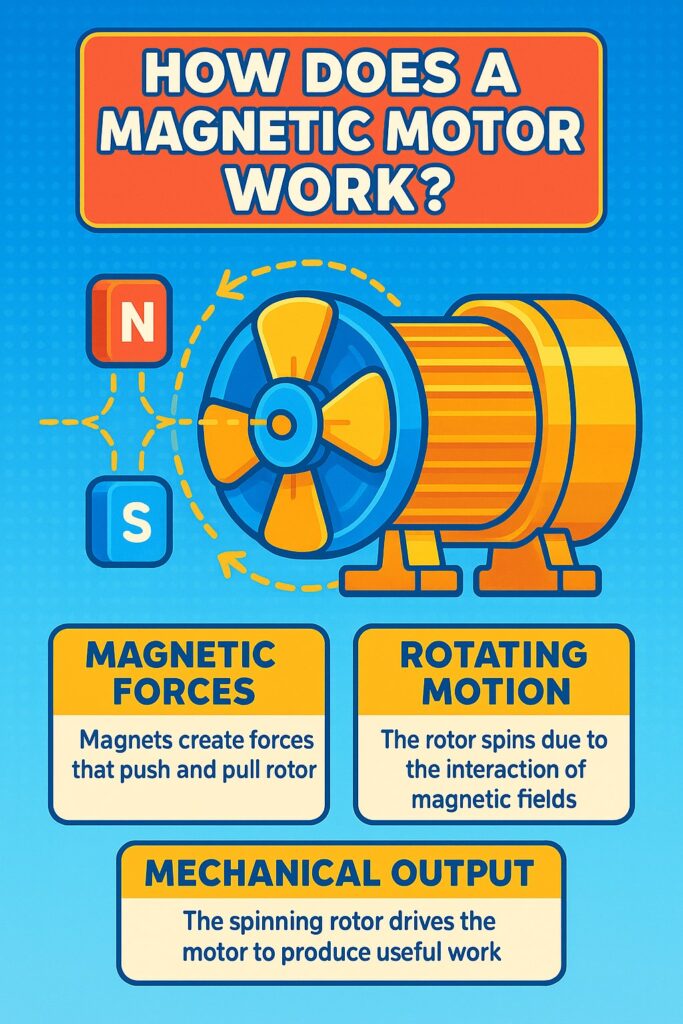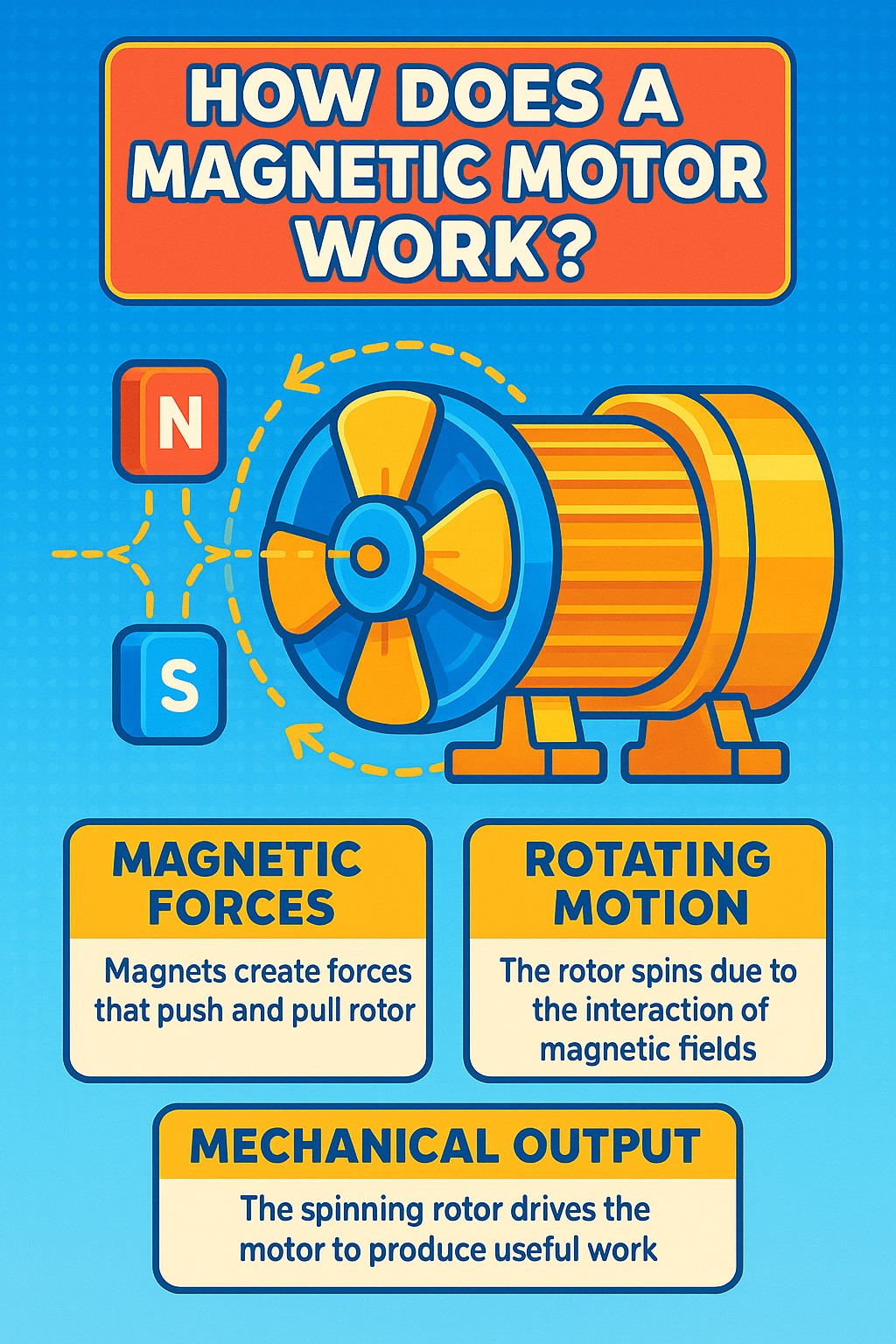How Does A Magnetic Motor Work ?

A magnetic motor is a fascinating device that uses the natural forces of magnetism to create motion. Unlike traditional motors that rely on fuel or electricity, magnetic motors aim to harness the push and pull of magnetic fields to rotate a shaft and generate mechanical energy. But how exactly does this work? In this article, we’ll dive deep into the science behind magnetic motors, break down their components, explain how they operate, and look at the benefits and limitations of this unique technology.
Let’s explore the inner workings of magnetic motors and understand what makes them function.
What Is a Magnetic Motor?
A magnetic motor is a type of device designed to convert magnetic energy into mechanical motion. It does this by using the repulsive and attractive forces between magnets to create rotation. The motor typically consists of permanent magnets arranged in such a way that their interaction leads to continuous movement of a rotor without direct fuel or electricity once initiated.
Some designs aim to achieve continuous rotation, while others are used in hybrid systems with external power sources to enhance efficiency. It’s important to understand that magnetic motors are often discussed in theoretical or experimental contexts, and their practical applications are still under development.
Core Components of a Magnetic Motor
To understand how a magnetic motor works, it helps to know the key parts involved in its construction. While designs can vary, most magnetic motors include the following components:
-
Rotor: This is the central part of the motor that spins. It is mounted on a shaft.
-
Magnets: Strong permanent magnets are strategically placed on both the rotor and the stationary part of the motor.
-
Stator: The stationary frame or housing that may also contain magnets or magnetic field guides.
-
Bearing Assembly: Allows the rotor to spin smoothly.
-
Frame or Housing: Holds everything together in alignment.
The careful placement and polarity orientation of the magnets are critical to the motor’s operation.
The Science of Magnetic Forces
At the heart of the magnetic motor is the principle of magnetism. Magnets have two poles: north and south. Like poles repel each other, while opposite poles attract. This fundamental rule forms the basis of how magnetic motors generate motion.
When magnets are arranged with alternating polarities, the repelling and attracting forces can be used to push and pull a rotor. As the rotor moves, it enters the influence of other magnetic fields, creating a chain reaction that can lead to rotation.
This concept is often supported with:
-
Permanent Magnets: Made of materials like neodymium or ferrite, they offer strong and consistent magnetic fields.
-
Magnetic Repulsion/Attraction Cycles: As the rotor spins, it constantly interacts with new magnetic fields.
How Motion Is Generated
The working principle of a magnetic motor lies in leveraging these magnetic interactions to keep the rotor moving. Here’s a simplified explanation of how that happens:
-
Initial Push or Start: The rotor receives an initial push, either manually or using a small external power source.
-
Magnet Interactions: As the rotor spins, the magnets on it begin to interact with those on the stator.
-
Repulsion and Attraction: Depending on the orientation, magnets repel or attract, pushing or pulling the rotor forward.
-
Continuous Rotation: With careful alignment, the rotor continues to spin due to a cascading magnetic effect.
Some designs use clever arrangements or shielding techniques to reduce magnetic drag and maintain momentum.
Challenges and Limitations
While the idea of a motor running entirely on magnets is exciting, there are practical challenges that make fully self-sustaining magnetic motors difficult to realize:
-
Magnetic Drag: As magnets repel or attract, they also create resistance in certain positions, which can slow the rotor down.
-
Energy Loss: Friction in the bearings and air resistance can gradually reduce the rotor’s speed.
-
No Perpetual Motion: According to the laws of thermodynamics, no machine can run forever without input. This means magnetic motors, like all machines, require some form of energy input or maintenance.
That said, magnetic motors are not useless. They are being explored in specialized applications and hybrid models where magnetic forces improve efficiency.
Benefits of Magnetic Motors
Despite the challenges, magnetic motors have potential advantages that make them attractive for certain uses:
-
Energy Efficient: Magnetic forces can reduce the load on electric motors, lowering energy consumption.
-
Low Maintenance: Fewer moving parts and no combustion lead to longer operational life.
-
Environmentally Friendly: No emissions or fuel usage.
-
Silent Operation: These motors are typically very quiet.
In experimental setups, magnetic motors have shown promise in reducing wear and tear in mechanical systems.
Applications in Research and Innovation
Although magnetic motors are not yet common in mainstream use, researchers and engineers are investigating several areas where they might prove valuable:
-
Educational Demonstrations: Used in physics experiments to demonstrate magnetic force and rotational motion.
-
Prototypes for Clean Energy: Studied as potential components in renewable energy technologies.
-
Assistive Devices: Used in low-power systems for movement assistance.
While the dream of a completely self-powered magnetic motor is still distant, innovations in magnetic materials and design may unlock more practical uses in the future.
Common Misconceptions
There’s a lot of hype around magnetic motors, particularly online, where they’re sometimes promoted as “free energy” or perpetual motion machines. These claims are misleading. Let’s clear up a few myths:
-
Not Perpetual: Magnetic motors do not violate the laws of physics. They eventually lose momentum without input.
-
Not Free Energy: While they can be efficient, they still require an initial energy source or maintenance.
-
Not a Replacement for All Motors: Magnetic motors are more suitable for niche applications, not for replacing all existing engines or generators.
Being realistic about what magnetic motors can and can’t do helps focus innovation where it truly matters.
Final Thoughts
So, how does a magnetic motor work? It operates on the principle of magnetic attraction and repulsion to create rotary motion. Using permanent magnets and smart design, the rotor moves in response to the forces acting on it. While not a magic energy source, magnetic motors represent an intriguing direction in energy-efficient mechanical design.
With more research and engineering improvements, magnetic motors may become important components in eco-friendly machines, learning environments, or hybrid energy systems. For now, they remain a valuable tool for experimentation and innovation.
Key Takeaways
-
A magnetic motor uses magnetic forces to produce motion.
-
It relies on the interaction between permanent magnets on a rotor and stator.
-
Though not capable of perpetual motion, it can reduce friction and energy use.
-
Magnetic motors are mostly experimental, but show promise in niche areas.
-
They offer clean, low-maintenance, and silent alternatives to traditional motors.
By understanding how magnetic motors work, we unlock new ways to think about motion, energy, and future technologies.
References
https://en.wikipedia.org/w/index.php?title=Magnetic_motor&redirect=no
Links License – https://en.wikipedia.org/wiki/Wikipedia:Text_of_the_Creative_Commons_Attribution-ShareAlike_4.0_International_License
Dear Friends, warmly welcome you to visit link below for tech products at my website. Thanks For Your Support.
https://techsavvo.com/category/tech-products/


